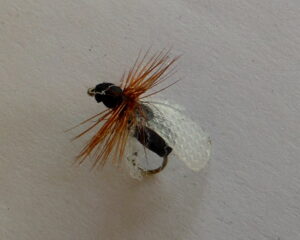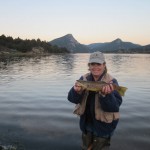This season’s snow pack promises plenty of water this summer. That is good news for folks needing irrigation water but not so much for anglers eagerly anticipating sunny days fishing in the high lakes in Rocky Mountain National Park. It’s a convenient coincidence that this lack of easy access comes when many of us are not at the peak of conditioning, even after a winter spent aerobically tying flies.
The streams and lakes in Estes Park at the “lower” elevations from 8500’ down were fishing great before the run-off came our way. Take advantage of this early season access near Lake Estes by fishing the Big Thompson River where it enters the lake by the 9-hole golf course. The trick is to fish early in the day before the runoff from a warm day melts the snow in RMNP and brings turbid water our way.
Or you can follow the trail to the west, across the bridge, to where the power plant might be running and creates a second inlet with warmer water. The discharge here is usually clear after the trip from Grand Lake through the Adam’s tunnel. When the power plant turbines are running, the area between the power plant and the lake is productive.
Below the lake, the Olympus Dam controls the flow down the Big Thompson Canyon. This popular stretch of accessible water is strictly artificial lures/catch and release from the dam downstream 8 miles to Waltonia Bridge. The settling and warming effect of Lake Estes plus the scouring this river bed has received recently keep sediment and turbidity to a minimum. The downside of this stretch is the popularity. Estes Guide services use this area heavily but only during “regular” hours. The trick right below the dam is to either fish it as the sun rises or after it sets. Go there when most folks are standing in lines at local restaurants and you will be rewarded.
We love to fish dry flies and rarely use nymphs. That being said, this is a great time of year to drift a bead head-flash back-pheasant tail nymph down the stream. In the evening, we mostly use a floating flying ant pattern. The ones with cellophane wings will reflect sunlight and flash in the setting sun. This fly must resemble a lot of different insects since its accepted most of the year. A dead drift is always a good presentation, but we find a short “skitter” and stop seems to get attention from the big lazy browns. It also helps us locate the fly when it’s getting dark and we just have to watch for the rise form.

